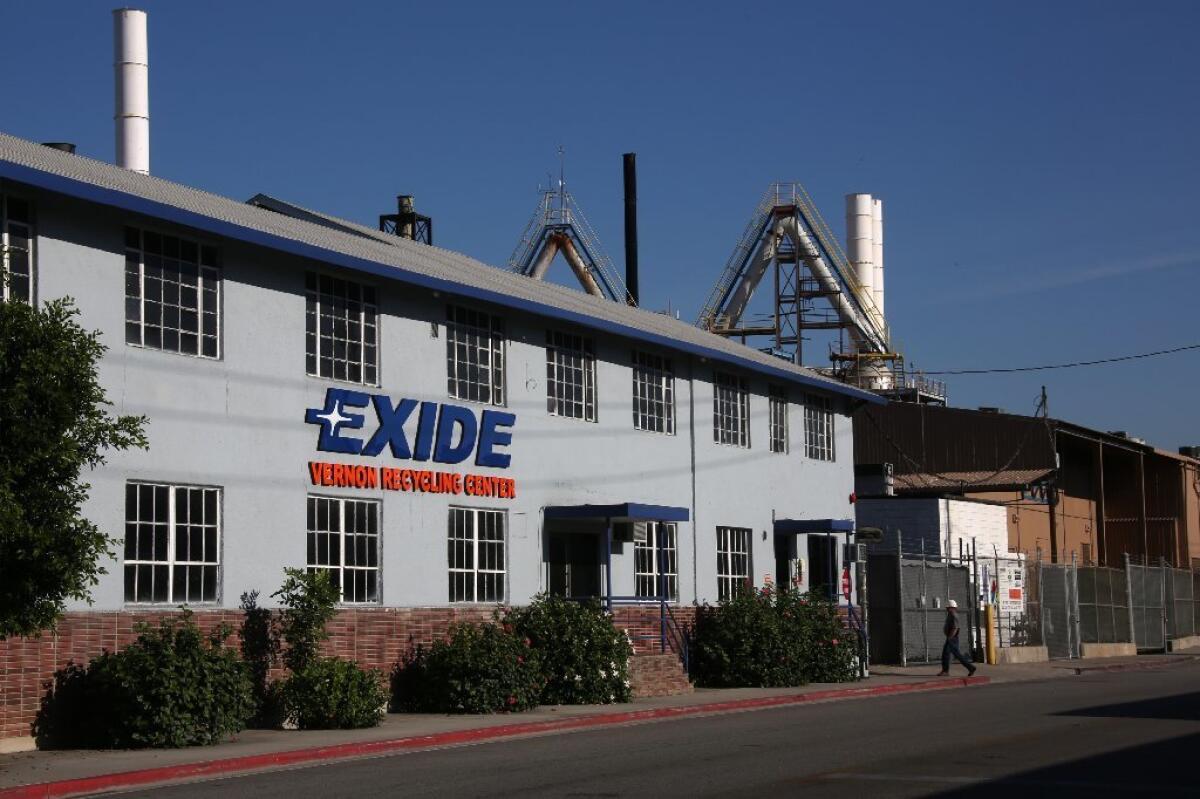Criticized over a delay on Exide, regulators move to clean homes with the worst lead contamination

California regulators moved Thursday to accelerate soil cleanups and other actions to prevent exposure to lead contamination at the highest-risk homes near the shuttered Exide Technologies plant in Vernon. The change of course follows months of criticism by community groups, lawmakers and health officials about government inaction.
New guidelines issued by the state Department of Toxic Substances Control will allow for a “limited number” of residential properties posing the highest risk of lead poisoning to undergo expedited, “time critical removal actions.”
The largest-ever cleanup of lead-contaminated homes in California has been at a standstill since June. The department argued previously that it could not complete any cleanups — even of homes whose lead levels amounted to hazardous waste — until a year-long environmental review is completed this summer.
The cleanup spans 10,000 residential properties as well as daycare centers, schools and parks across seven southeast Los Angeles County communities surrounding the former car battery-smelting plant, which regulators blame for emitting dangerous lead contamination over decades.
Although state officials long maintained they could not complete cleanups using exemptions in state law because the levels of contamination were not considered an emergency, county health officials, community groups and legal experts disagreed and were among those who pushed for quicker action amid the ongoing environmental review.
They contended there was nothing in the law preventing the department from acting immediately to remove lead from the highest-risk properties, particularly those with lead levels above 1,000 parts per million — the state’s threshold for hazardous waste.
The guidelines, released Thursday, indicate that the department found the legal justification.
The toxics department cited concerns from community members and local leaders in its decision to release guidelines, developed in consultation with the U.S. Environmental Protection Agency, that will allow it to complete expedited cleanups in the next few months while complying with the California Environmental Quality Act.
“We are utilizing all of the resources at our disposal to ensure that we are able to take action to protect the most sensitive populations impacted by the presence of lead in the soil from the Exide operations,” DTSC Director Barbara Lee said in a statement.
The shift comes just a few weeks after Lee said people living near Exide would have to wait for cleanup until June, when the environmental review of the project is scheduled to be completed.
Lee said in a December interview that exemptions to the California Environmental Quality Act examined by the department were not straightforward.
The toxic substances department said Thursday it is now screening for expedited action properties where statistical analysis shows lead levels exceeding 1,000 ppm and evaluating sampling data for evidence of “localized exposures” to high levels of lead.
The department will also consider other factors, such as the presence of pregnant women, children under age 7 or people with high levels of lead in their blood, and will make decisions about which properties to target “on a case-by-case basis where the analysis shows an imminent threat to sensitive individuals is likely.”
Lead, a potent neurotoxin, is most dangerous to young children who can ingest contaminated soil or dust. Even small amounts of the metal cause permanent learning and developmental deficiencies, lower IQs and behavioral problems.
The state’s interventions at the highest-risk properties could include soil removal but could also be limited to less comprehensive measures, such as the installation of grass, mulch or rock barriers. The remediation steps would be taken only with the permission of property owners and tenants.
DTSC officials had no estimate of how many properties could be selected for expedited cleanups, which are expected to take place from now until when the environmental review is expected to be finalized in June.
“Since the Department will determine whether to take expedited cleanup or other time-sensitive actions on a case-by-case basis, it’s unknown at this time how many actions will be conducted under this guidance,” said Abbott Dutton, a DTSC spokeswoman.
A recent cleanup plan shows 52 of 2,711 residential properties tested through July 2016 had site-wide soil levels that exceeded 1,000 parts per million.
Nearly 30% of homes tested over the same period exceeded the federal health standard of 400 parts per million considered hazardous in bare soil where children play, and more than 97% were above California’s more stringent cleanup standard of 80 ppm, the department found.
The department’s decision to act sooner to clean some properties was cheered by experts on the California Environmental Quality Act who had been critical of its failure to take advantage of exemptions to the law.
“That’s more like it,” said Douglas Carstens, an environmental attorney based in Hermosa Beach. He praised the department for developing “creative ways” to balance competing cleanup priorities.
“Everybody wants the same thing — a good cleanup to protect public health — and it seems the only differences have been about timing and prioritization,” Carstens said.
Oakland-based environmental attorney Richard Drury applauded the move but said expedited cleanup should be expanded to properties above the federal standard of 400 parts per million.
“Lead is a highly toxic chemical and levels above 400 ppm are sufficiently significant to warrant emergency cleanup,” Drury said.
About 235 residential properties near the plant have been cleaned so far, most of them in initial areas near the plant that were identified more than three years ago. The last home cleanup occurred in June 2016.
Community groups and state lawmakers critical of the pace of cleanup welcomed the decision by the department to act sooner than this summer.
“We’re encouraged that there are steps forward to clean up those homes with immediate health risks, but still frustrated it’s taken this long,” said Assemblyman Miguel Santiago (D-Los Angeles). He said he spent months pushing the DTSC to address “an imminent danger to people in our neighborhood.”
Mark Lopez, who directs East Yard Communities For Environmental Justice, welcomed the prospect of a quicker cleanup but fears a clumsy implementation, saying “there’s still a lack of trust in the department and how its contractors handle cleanup.”
Lopez said he was also concerned the plan signaled “that barriers and ground cover will be used instead of cleanup in favor of saving time and saving money.”
Exide agreed to close its Vernon plant permanently in March 2015 after years of environmental violations and a federal criminal investigation.
Under legislation signed by Gov. Jerry Brown last year, California allocated $176.6 million for soil testing and remediation of properties, which officials hope to recoup from Exide and any other responsible parties.
Those funds will pay for cleaning lead from an estimated 2,500 of those parcels within a two-year period starting this summer.
Full cleanup is expected to cost hundreds of millions of dollars.
Assemblywoman Cristina Garcia (D-Bell Gardens) said Thursday she was pleased state regulators’ decision to accelerate cleanup of the most severely contaminated homes. She urged the department to proceed “as soon as possible considering the health impacts of living with lead exposure.”
“These families have had no choice but to live in this contamination for years,” Garcia said. “They cannot afford to wait any longer. ”
ALSO
More than 40% of California no longer in drought, data show
City of Industry shoe company recalls boots after Reddit user finds swastika design on soles
Will a surf gang allow the integration of Palos Verdes Estates’ waves on Martin Luther King Jr. Day?
UPDATES:
6:15 p.m.: This article was updated with additional details and comments from environmental attorneys and a state assemblywoman.
This article was originally published at 3:45 p.m.
More to Read
Start your day right
Sign up for Essential California for news, features and recommendations from the L.A. Times and beyond in your inbox six days a week.
You may occasionally receive promotional content from the Los Angeles Times.








